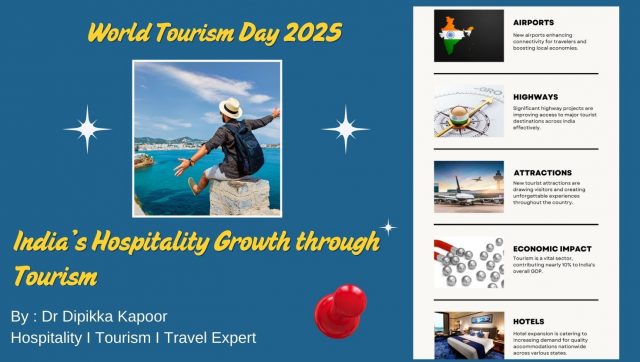By Dr Dipikka Kapoor
Over my journey in hospitality and tourism spanning more than three decades, I have witnessed how the face of Indian tourism has transformed into a global success story. India’s tourism and hospitality sectors have emerged as cornerstones of growth, driving the economy, creating jobs, and redefining how travellers experience the country. Today, India stands as one of the world’s most dynamic tourism destinations, not only because of its cultural heritage but also due to strong infrastructure development, technological adoption, and global-standard hospitality practices.
In recent years, significant state-wise infrastructure advancements have reshaped travel accessibility. Air connectivity has improved drastically, with new airports such as Dehradun’s Jolly Grant Airport upgraded for international flights, Pantnagar Airport gaining traction for domestic connectivity in Uttarakhand, and the upcoming Jewar Airport in Noida poised to be among Asia’s largest aviation hubs. The new airport at Kushinagar has already become a key international gateway for Buddhist tourism in Uttar Pradesh, while Ladakh is set to benefit from new airstrip expansions catering to growing adventure and cultural tourism. Enhanced railway connectivity, including Vande Bharat Express trains, has bridged major cities and pilgrimage routes, making travel seamless for domestic and international tourists alike.
Road infrastructure has equally played a critical role. The expansion of expressways such as the Delhi-Meerut Expressway, Purvanchal Expressway, and the Char Dham all-weather road project in Uttarakhand has boosted religious and leisure tourism. States like Rajasthan, Gujarat, and Maharashtra have seen new highways improving access to heritage cities, wildlife sanctuaries, and coastal destinations. Such developments not only improve last-mile connectivity but also position states as more tourist-friendly.
Tourism attractions have multiplied in the past decade. Uttarakhand has developed Tehri Lake as a hub for adventure sports and eco-tourism, while Gujarat introduced the Statue of Unity, now one of the most visited monuments in the world. In Jammu & Kashmir, the opening of new trekking routes and promotion of winter sports in Gulmarg has attracted global travellers. Madhya Pradesh has enhanced its wildlife tourism by upgrading safari facilities in Kanha and Bandhavgarh, while Odisha has revived cultural tourism through festivals and eco-retreats. This blend of natural, cultural, and modern attractions has made India’s tourism ecosystem more diverse and inclusive.
Parallel to infrastructure, the hospitality sector has evolved with speed and scale. Earlier dominated by legacy luxury brands such as Taj, Oberoi, and ITC, the market has expanded to include global players like Marriott, Hyatt, Accor, Hilton, and Radisson, along with fast-growing Indian mid-market chains such as Lemon Tree Hotels, Sarovar Hotels, and Treebo. Budget-friendly platforms like OYO and FabHotels have made quality accommodation accessible to younger travellers, backpackers, and business guests alike. The growth of homestays and boutique resorts has further personalised the experience, allowing tourists to engage with local culture more closely.
Hospitality trends are rapidly changing with technology integration. Artificial intelligence, contactless check-ins, virtual concierge services, and AI-powered revenue management tools are redefining operations and guest satisfaction. Sustainability has also become a priority, with eco-friendly hotels, renewable energy practices, and responsible waste management shaping the industry’s future. These trends are not just elevating guest experiences but also ensuring that tourism growth aligns with global environmental goals.
Tourism’s contribution to India’s GDP continues to rise, driven by domestic travellers and international arrivals. The sector contributes nearly 10% to India’s GDP, generating millions of jobs across airlines, hotels, travel agencies, and allied industries. The ripple effect is evident in rural economies, where tourism has become a sustainable livelihood source through crafts, cuisine, and cultural exchanges.
The journey of Indian hospitality and tourism has been a story of resilience, reinvention, and global recognition. From enhancing connectivity to expanding accommodation choices, from introducing world-class attractions to adopting AI-led innovations, India’s tourism landscape is stronger than ever before. As the country marches forward, hospitality will remain at the heart of this journey, welcoming the world with warmth and innovation.
(Dr Dipikka Kapoor is Founder & Director, DK Signature Hospitality & Travel, Bangalore.)






